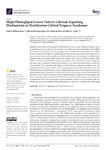Mostrar o rexistro simple do ítem
High-Throughput Screen Detects Calcium Signaling Dysfunction in Hutchinson-Gilford Progeria Syndrome
| dc.contributor.author | Fafián Labora, Juan Antonio | |
| dc.contributor.author | Morente López, Miriam | |
| dc.contributor.author | De-Toro, Javier | |
| dc.contributor.author | Arufe, M.C. | |
| dc.date.accessioned | 2021-08-17T07:40:27Z | |
| dc.date.available | 2021-08-17T07:40:27Z | |
| dc.date.issued | 2021-07-07 | |
| dc.identifier.citation | Fafián-Labora JA, Morente-López M, de Toro FJ, Arufe MC. High-Throughput Screen Detects Calcium Signaling Dysfunction in Hutchinson-Gilford Progeria Syndrome. Int J Mol Sci. 2021 Jul 7;22(14):7327. | es_ES |
| dc.identifier.issn | 1422-0067 | |
| dc.identifier.uri | http://hdl.handle.net/2183/28256 | |
| dc.description.abstract | [Abstract] Hutchinson–Gilford progeria syndrome (HGPS) is a deadly childhood disorder, which is considered a very rare disease. It is caused by an autosomal dominant mutation on the LMNA gene, and it is characterized by accelerated aging. Human cell lines from HGPS patients and healthy parental controls were studied in parallel using next-generation sequencing (NGS) to unravel new non-previously altered molecular pathways. Nine hundred and eleven transcripts were differentially expressed when comparing healthy versus HGPS cell lines from a total of 21,872 transcripts; ITPR1, ITPR3, CACNA2D1, and CAMK2N1 stood out among them due to their links with calcium signaling, and these were validated by Western blot analysis. It was observed that the basal concentration of intracellular Ca2+ was statistically higher in HGPS cell lines compared to healthy ones. The relationship between genes involved in Ca2+ signaling and mitochondria-associated membranes (MAM) was demonstrated through cytosolic calcium handling by means of an automated fluorescent plate reading system (FlexStation 3, Molecular Devices), and apoptosis and mitochondrial ROS production were examined by means of flow cytometry analysis. Altogether, our data suggest that the Ca2+ signaling pathway is altered in HGPS at least in part due to the overproduction of reactive oxygen species (ROS). Our results unravel a new therapeutic window for the treatment of this rare disease and open new strategies to study pathologies involving both accelerated and healthy aging. | es_ES |
| dc.description.sponsorship | This work was funded by the Spanish National Health Institute Carlos III (PI20/00497) awarded to M.C.A. Furthermore, J.A.F.-L. is funded by the Xunta de Galicia Fellowship (ED481D-2021-020) | es_ES |
| dc.description.sponsorship | Xunta de Galicia; ED481D-2021-020 | |
| dc.language.iso | eng | es_ES |
| dc.publisher | MDPI | es_ES |
| dc.relation | info:eu-repo/grantAgreement/ISCIII/Plan Estatal de Investigación Científica y Técnica y de Innovación 2017-2020/PI20%2F00497/ES/TERAPIA CELULAR CON MICRO ARN Y VESICULAS EXTRACELULARES PARA EL TRATAMIENTO DE LA INFLAMACION CRONICA EN UN MODELO DE OA. (TERAPIA LIBRE DE CELULAS)/ | |
| dc.relation.uri | https://doi.org/10.3390/ijms22147327 | es_ES |
| dc.rights | Creative Commons Attribution 4.0 International License (CC-BY 4.0) | es_ES |
| dc.rights.uri | https://creativecommons.org/licenses/by/4.0/ | * |
| dc.subject | HGPS | es_ES |
| dc.subject | Ca2+ signaling | es_ES |
| dc.subject | GRP75 | es_ES |
| dc.subject | GRP78 | es_ES |
| dc.subject | NAC | es_ES |
| dc.subject | ROS | es_ES |
| dc.title | High-Throughput Screen Detects Calcium Signaling Dysfunction in Hutchinson-Gilford Progeria Syndrome | es_ES |
| dc.type | info:eu-repo/semantics/article | es_ES |
| dc.rights.access | info:eu-repo/semantics/openAccess | es_ES |
| UDC.journalTitle | International Journal of Molecular Sciences | es_ES |
| UDC.volume | 22 | es_ES |
| UDC.issue | 14 | es_ES |
| UDC.startPage | 7327 | es_ES |
| dc.identifier.doi | 10.3390/ijms22147327 |
Ficheiros no ítem
Este ítem aparece na(s) seguinte(s) colección(s)
-
GI-TCMR - Artigos [131]
-
INIBIC-TCMR - Artigos [102]






